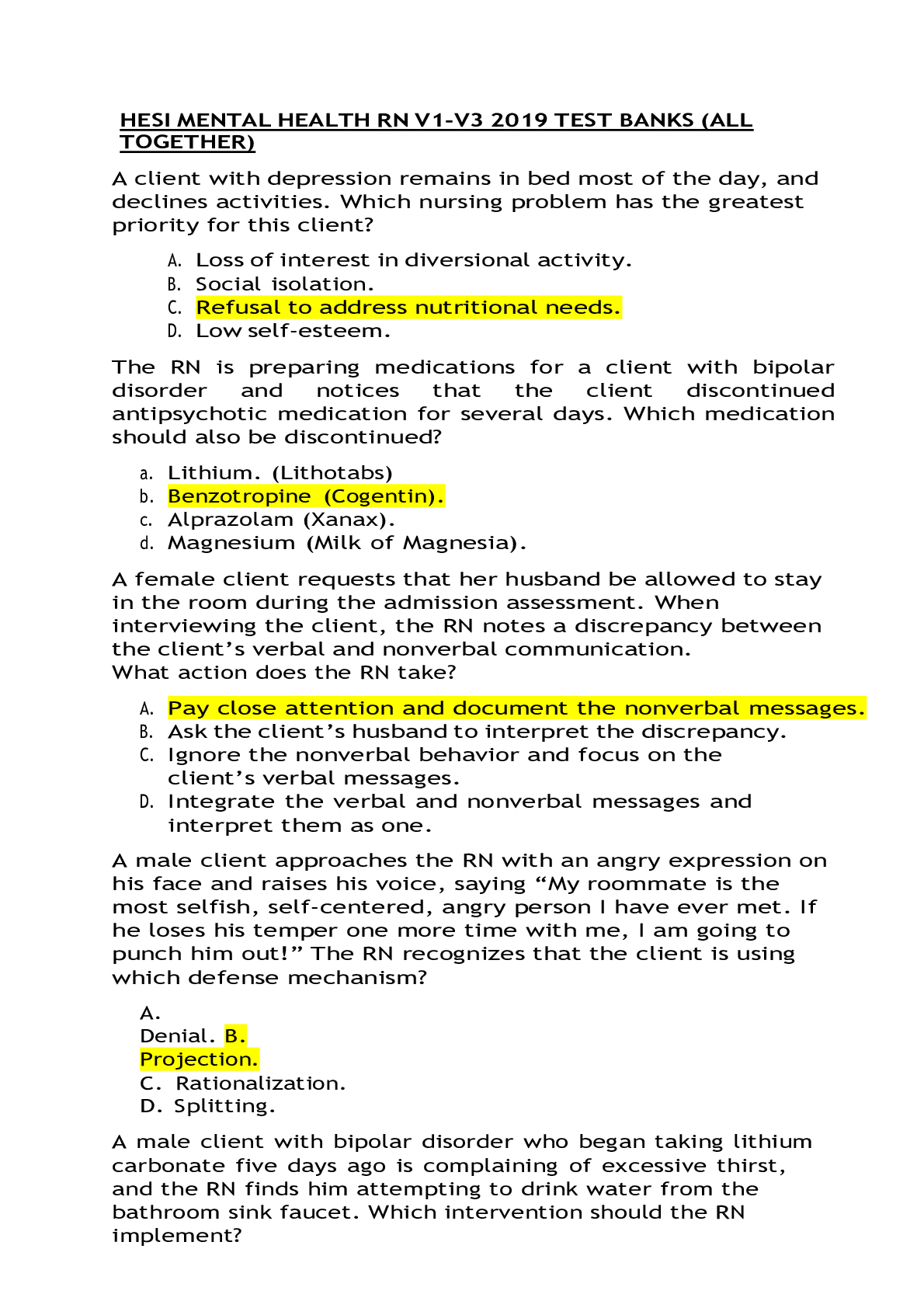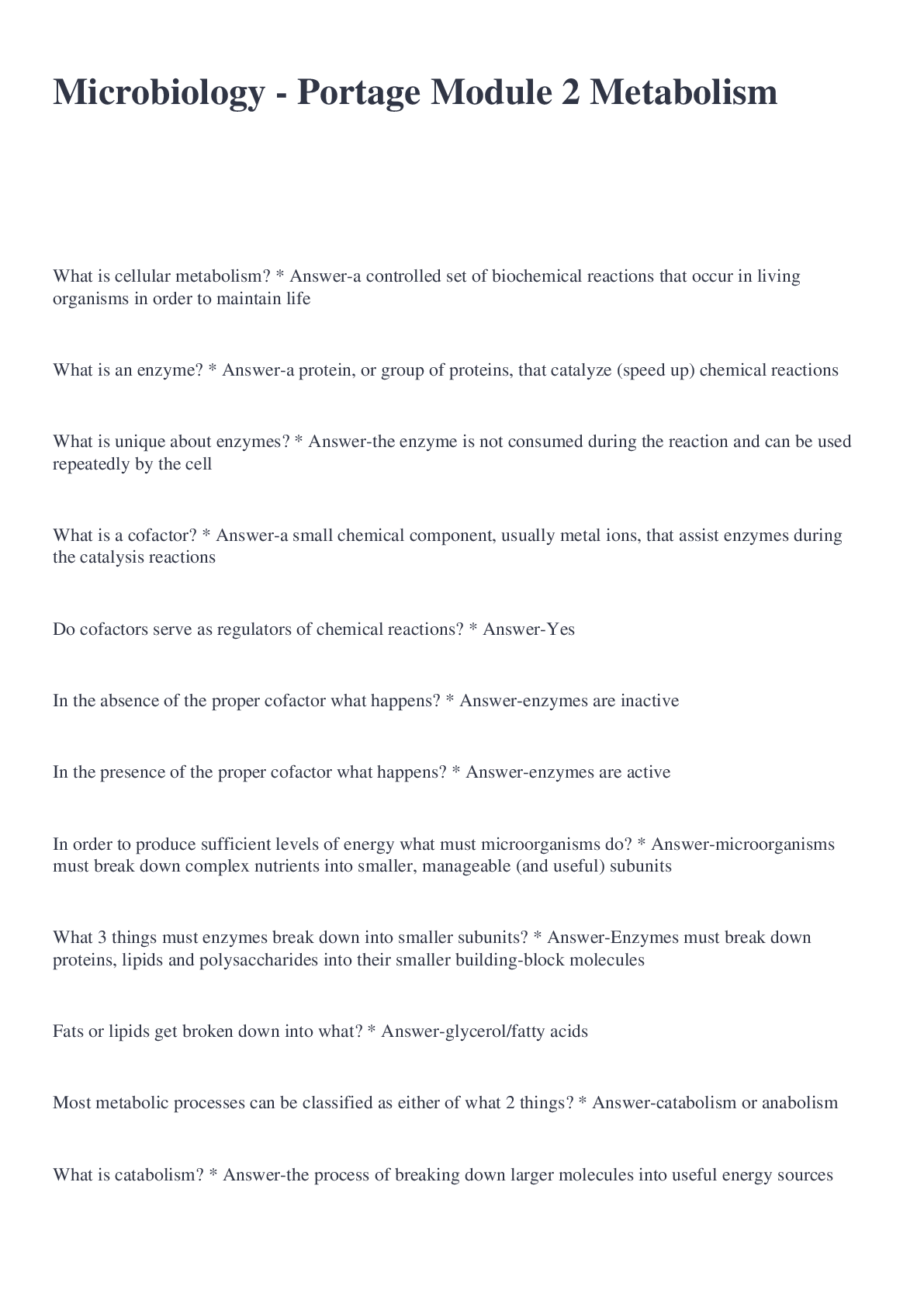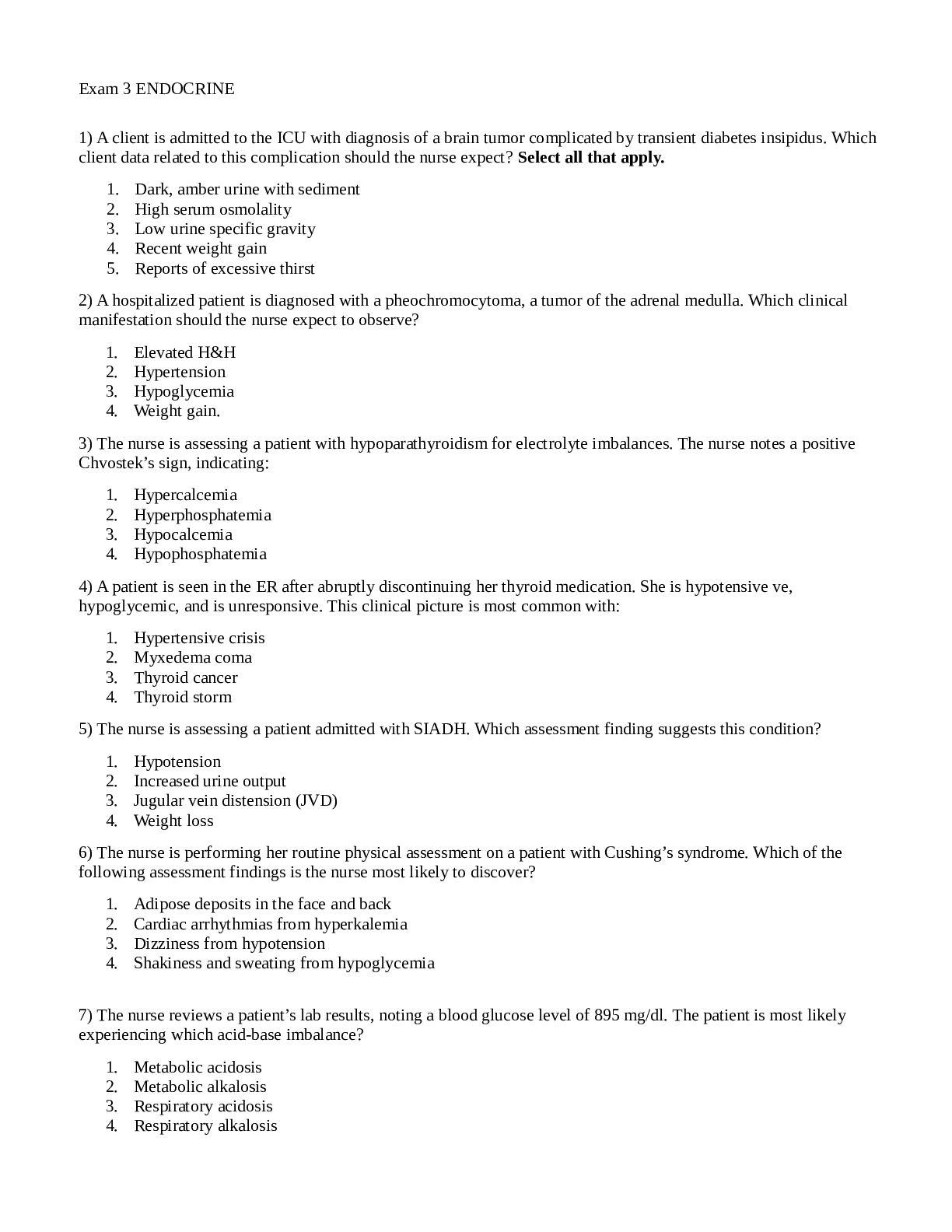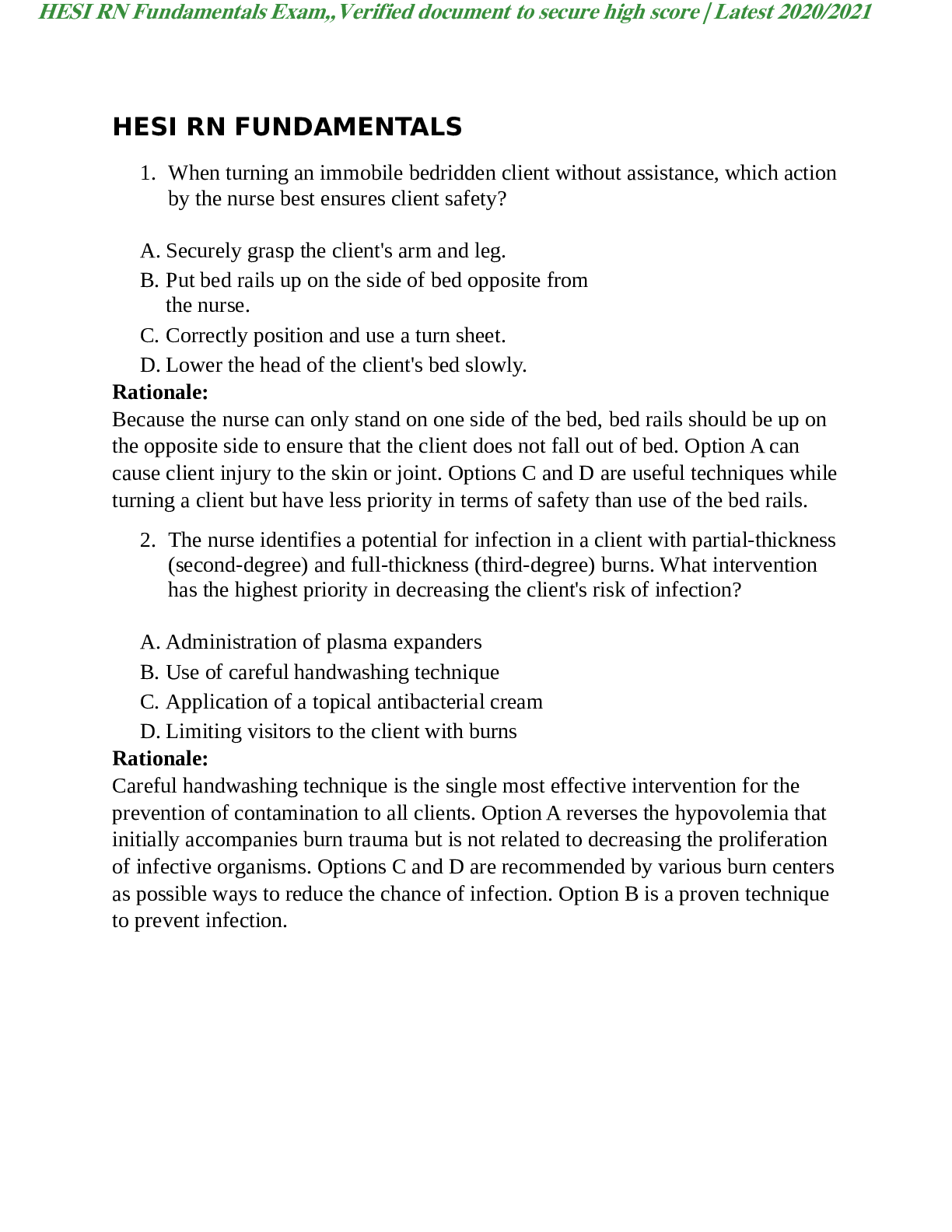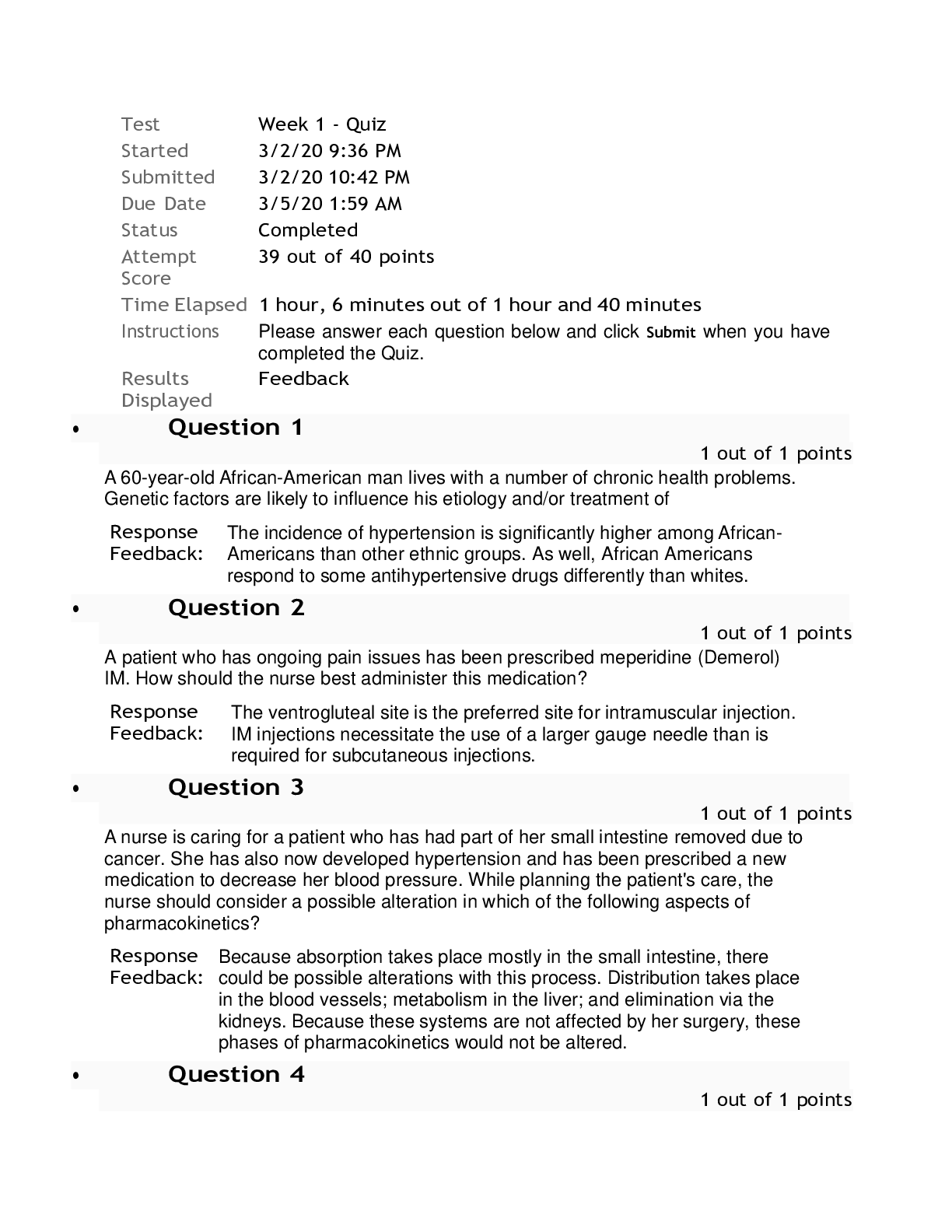*NURSING > QUESTIONS & ANSWERS > NR228 Nutrition, Health, & Wellness- Exam 1 Guide (All)
NR228 Nutrition, Health, & Wellness- Exam 1 Guide
Document Content and Description Below
NR228 Nutrition, Health, & Wellness Study Guide Exam 1 Chapter 1: Wellness Nutrition • Describe the main purpose of health promotion through patient education. – it’s used to increase the lev... el of health of individuals, families, groups, & communities • What is the purpose of Healthy People 2020 (HP2020)? – to increase awareness and understanding, provide objectives, identify critical research, eval, and data needs • What are the overarching goals of Healthy People 2020 per the direction of U.S. Department of Health and Human Services (USDHHS)? – attain high quality, longer lives free of disease, disability, injury and death; achieve health equity, create social and physical environments, promote quality of life, health development and behaviors • What are carbohydrates, proteins, lipids (fats), vitamins, minerals, & water are examples of? – 6 nutrient categories • What are the components of proteins, fats, and carbohydrates? – carbs – sugars, starch, fiber; proteins (amino acids) – animal sources & dairy products like milk & cheeses, plant sources – grain, legumes, seeds, nuts, veggies • What are the energy values for each nutrient and how is that used to calculate Kcal? – carbs – 4, proteins – 4, fats – 9, alcohols - 7 • What is the difference between essential and non-essential nutrients? – essential provides energy, regulates body processes, aids in growth and repair (body can’t make it), non-essential is created from the body Chapter 2: Personal and Community Nutrition • Review the terms associated with food selection: o Food preferences – foods we choose to eat when all foods are available at the same time & quantity o Food choice – specific foods that are convenient to choose from when we are actually ready to eat • Review the various tools for nutrition and meal planning. Gain an understanding of the use for the tool and what patients may use it. This should include but not be limited to: o Dietary Guidelines for Americans – forms lifestyle & daily pattern recommendations o MyPlate – internet-based tool providing recommendations based on age, sex, & activity level o Exchange List for Meal Planning – a resource for serving sizes o Dietary Reference Intakes - o Dietary standards - o Recommended Daily Allowance - o Acceptable Macronutrient Distribution Ranges - NR228 Nutrition, Health, & Wellness Study Guide Exam 1 o Tolerable Upper Intake Level – the highest level of daily nutrient intake that is likely to pose no risk of adverse effects • What is a daily food plan? – a food plan that meets the needs of a person requiring 2000 cals/day • Know what information is required on the Nutrition Facts panel: total fats (sat & trans), total carbs (sugars & fiber), cholesterol, Na, total carbs (fiber & sugars), Vit. A & C, Ca, Iron • What are the definitions for different food descriptors? – free (has a tiny amount), low (can be eaten fairly often), lean (not as lean as low used for poultry), extra lean (leaner than lean not as lean as low), reduced, less, fewer (25% less of a nutrient or cals); light (contains 1/3 few cals than the original), more (contains 10% more of the daily value), good source of (contain 10-19% of daily value) • What is the purpose of food label descriptors and health claims? – to help consumers who try to control their intakes of specific nutrients & food components • What is meant by “certified organic”? – the food is certified as fulfilling the USDA standards for farming &/or rearing of animals NOT how the ingredients have been processed during the manufacturing procedures Chapter 3: Digestion, Absorption & Metabolism • What are the supportive structures and organs of the digestion system? – the mouth, esophagus, stomach (fundus, body, pylorus), small intestine (duodenum, jejunum, ileum), large intestine (cecum, colon, rectum) • What are the three types of muscular actions of the GI tract? – digestion, absorption, & metabolism • What is the role of each organ in both digestive and absorption? o Small intestine – completes digestion, absorbs nutrients o Large intestine – final absorption of water, forms and stores feces NR228 Nutrition, Health, & Wellness Study Guide Exam 1 o Liver – breaks down & builds up molecules, stores vitamins & iron, destroys old RBC & poisons, produces bile o Pancreas – secretes hormones to regulate BS levels, neutralizes stomach acid o Salivary glands – moistens and lubes up food, (amylase digests carbs) o Stomach – stores & churns food, HCl in stomach activates enzymes, breaks up food, kills germs • What issues across the lifespan can affect digestive processes? – allergies, immature GI tract of infants, middle aged – gallbladder disease and peptic ulcers, lactose intolerance, older aged – constipation & diverticulosis • What are expected changes in metabolism as a person advances to older age? – lowered metabolic rates • What is the function of metabolism? – converts food to energy Chapter 4: Carbohydrates • Identify simple carbohydrates versus complex carbohydrates and their components. – simple carbs – sugar, glucose, honey, milk, juice, syrup; complex carbs – pasta, grains, rice, plants, breads, oats, corn, barley, legumes • What are the dietary recommendations (DRI and AMDR) for carbohydrates? DRI – 130g/day for adults 19-30, AMDR – 45 to 65% cals/day • What function do carbohydrates play as a source of energy and dietary fiber for the patient? - • What are the differences and health benefits of soluble versus insoluble fiber? – soluble fiber can be broken down with water. The health benefits would be weight loss, peristalsis, healthy heart, diabetes control • What is the difference in the nutrient content of refined versus unrefined grains? – unrefined is prepared for consumption while they keep their original components; refined has been taken apart Chapter 8: Water and Minerals (pages 129–134 and 144–146) • What is the function of water for the human body? – lubricant, source of trace minerals, reactant, reg of body temp, structural component of cells • What is the difference in water requirements of male versus female patients? – males get 13 cups a day, women get 9 • Identify some of the numerous dietary sources of water. – fluids, fruits, veggies • What are foods high in sodium? – table salt, processed foods (spam, ramen, soy sauce) Chapter 9: Energy, Weight, and Fitness (pages 166-186) • How would a nurse define a healthy weight? – pt can physically move comfortably, live w/out any wt related associative disorders, maintained w/out undue restriction of food intake or w/out excessive exercise • What factors influence body fat levels? – genetics vs environment, hormones, genetic effects on body weight NR228 Nutrition, Health, & Wellness Study Guide Exam 1 • What is the BMR and what factors can affect a patient’s BMR? – BMR is the number of calories your body needs to accomplish its most basic (basal) life-sustaining functions; factors are age, body size, sex, body temp, fasting/starvation stress, menstruation, thyroid function, lean body mass • Which methods would a nurse use for assessing body fat composition and body weight? – densitometry, BIA, measure of skinfold thicknesses & body circumference • What are the ranges for BMI? – less than 18.5 (underweight), 18.5-24.9 (normal), 25- 29.9 (overweight), over 30 (obese) • How do you calculate BMI? – wt in lbs times 703/ht in inches squared • What is the healthy body (total) fat percentage for women and men? – 15-20% in men; 25-30% in women • How are the nutritional needs of athletes different from non-athletic patients? – athletes are no different than non-athletes, they eat more cals and drink more fluids than a non-athletic pt. • What are the recommendations for exercise? – start 3x/wk 30 mins/day gradually increase to 5x/wk • Which is better, water or sports drinks to replace fluids during exercise? – water for activities lasting less than 1 hour, sport drink for exercise lasting longer than 90 mins or more Chapter 5: Fats • What is the major function of triglyceride in food and physiologically in the body? – major functions: source of energy, palatability, satiety & satiation, food processing, nutrient source; physiologically: stored energy, organ protection, temp regulator, insulation • Where does the digestion of lipids mainly occur? – in the small intestine • What is the difference between saturated, polyunsaturated, and unsaturated fats? What are some sources of each? – saturated is mainly animal based, polyunsaturated comes from oils, fish, & margarine; unsaturated is your nuts (peanuts and peanut oil, avocados, canola oil) • What are the functions of phospholipids and cholesterol? They form part of all cell membrane structure & serve as emulsifiers to keep fats dispersed in body fluids • What are the functions of sterols? precursors to bile, Vit. D., sex hormones, cells in the brain & CNS • What are some examples of foods high in cholesterol? shrimp, egg yolk, beef liver • Identify three types of lipids and list sources of each. Triglycerides (butter, margarines, & oils), phospholipids (lean meats, fish, oil seeds), & sterols (fruits, vegetables, veggie oils, whole grains) • What is the function of the linolenic and linoleic essential fatty acids? Linolenic acids are the main member of the omega-6 family, Linoleic is the main member of the omega-3 family • Identify some sources of Omega-3 fatty acids. Fish & Oils (Walnut, soybean,) wheat & oat germ NR228 Nutrition, Health, & Wellness Study Guide Exam 1 • From a nursing perspective, explain why digestion, absorption, and transportation of lipids in the body is so important. • What are three different types of lipoproteins and their functions? HDL, LDL, & VLDLs • What are the potential health concerns related to excessive dietary fat intake? Diabetes, HTN, CVD, certain types of cancer Chapter 6: Proteins • What is the recommended protein intake for adults? RDA is 0.8g/kg • How many amino acids are in the composition of protein? - 20 • How does the composition of protein differ from carbohydrate and lipids? – they’re organic compounds formed from chains of amino acids • What is the difference between essential and nonessential amino acids? – nonessential can be made from the body, essential you get from your diet • Which are examples of sources of complete and incomplete proteins? – complete protein – cheese, milk, froyo, beef, pork, shellfish; incomplete – cereal, grains, bread, peanuts & peanut butter, leafy greens, oats, pasta • How is protein digested, then absorbed as amino acids then becomes available to cells? – stomach secretes pepsinogen activated to pepsin by HCl, polypeptides pass to small intest., absorption through intestinal wall by active transport REQUIRES Vit B6 • What are the functions of protein? – growth & maintenance, creation of communicators (hormones) & catalysts (enzymes), immune sys response, F&E regulation, acid-base bal, transport • Define: o Vegan – eats all plant foods, no animal derived foods o ovo-lacto-vegetarian – eats all plant, dairy products, and eggs; no animal meat o lacto-vegetarian – eats plant foods & dairy products, no animal meat & eggs • Identify the pros and cons of each type of vegetarian diet Vegan – low fat & high fiber, Mg, folic acid, Vit. C & E, and iron; however, there is little Vit. D & B12, zinc, Ca, omega-3s [Show More]
Last updated: 2 years ago
Preview 1 out of 5 pages
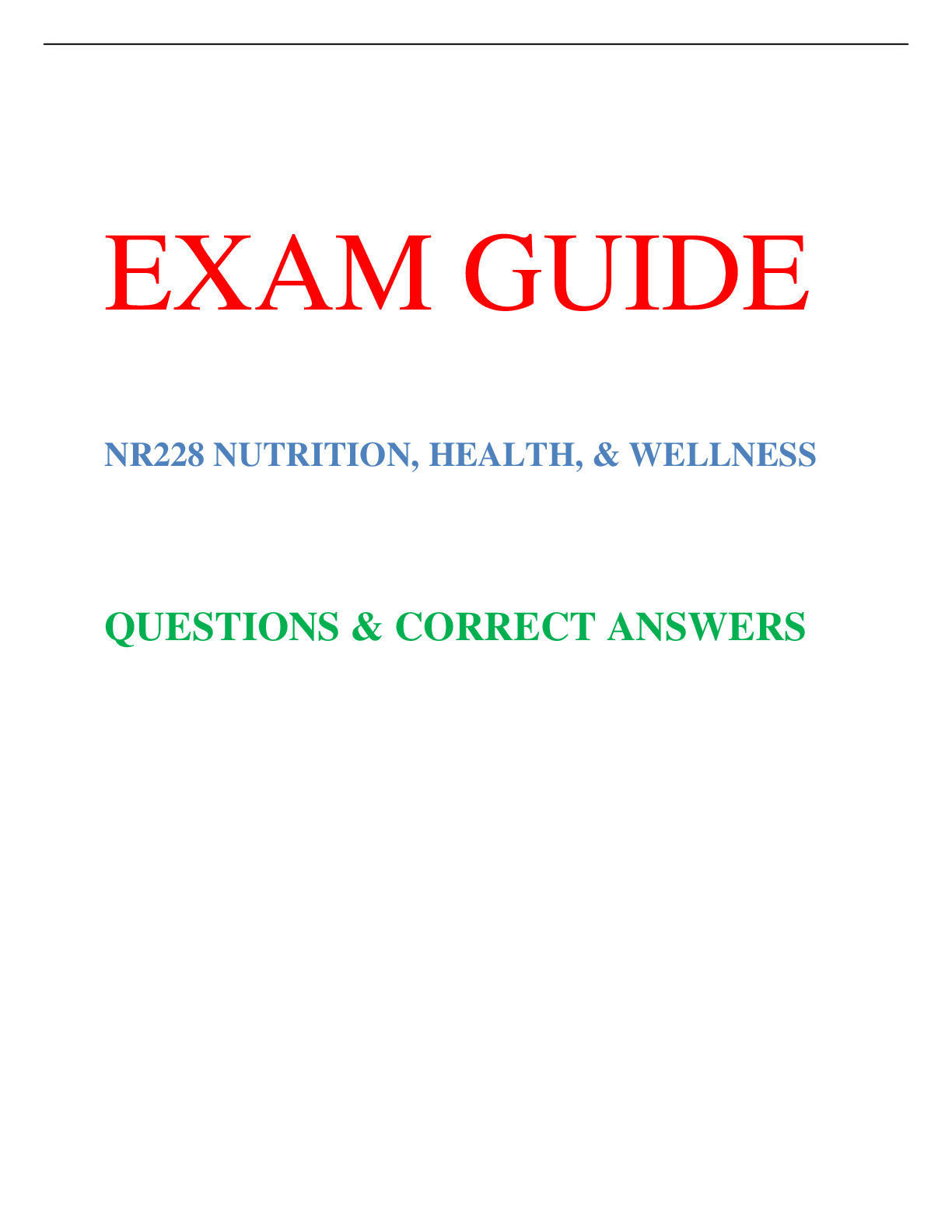
Buy this document to get the full access instantly
Instant Download Access after purchase
Buy NowInstant download
We Accept:

Reviews( 0 )
$12.50
Can't find what you want? Try our AI powered Search
Document information
Connected school, study & course
About the document
Uploaded On
Apr 22, 2021
Number of pages
5
Written in
Additional information
This document has been written for:
Uploaded
Apr 22, 2021
Downloads
0
Views
57

.png)
 HESI VI EXIT EXAM.png)
